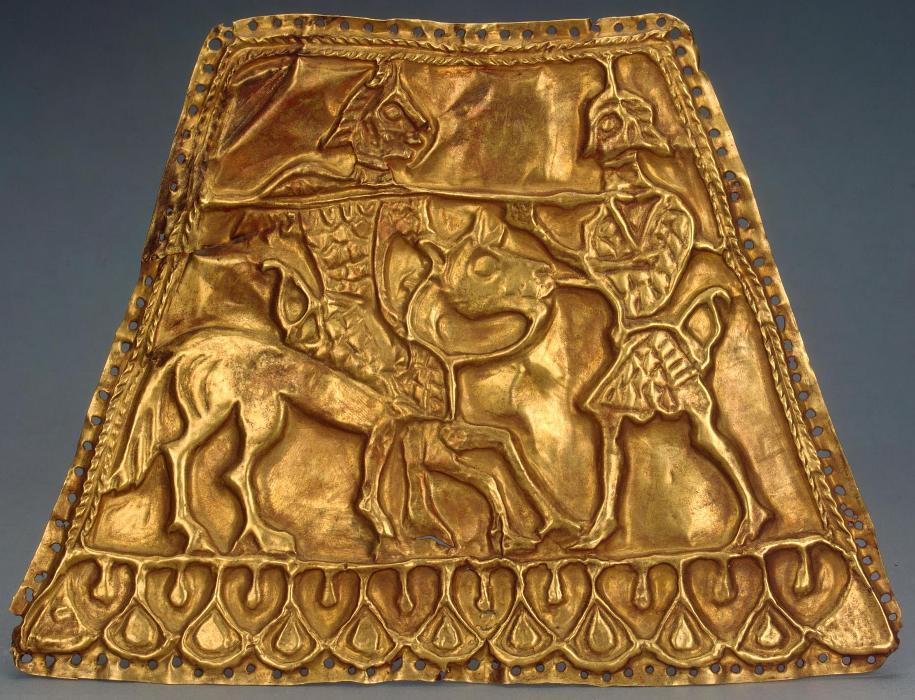
Shop Amazon - Create an Amazon Baby Registry
Plaque with Scythian Warriors, Geremes Barrow, Zaporozhye Region, 4th century BC

A larger image of Plaque with Scythian Warriors, Geremes Barrow, Zaporozhye Region, Hermitage Museum, St. Petersburg


Trapezium-shaped Plaque Decorated in Relief with Mounted and Dismounted Battle
Trapezium-shaped gold plaque decorated in relief with a combat of a mounted and dismounted warrior from Geremes Barrow is a rare example, almost without any parallel. It is a narrative piece of barbarian art. The armour and armament of the combatants faithfully rendered in the repousse technique are similar to those depicted by a Greek master on a comb excavated at Solokha Barrow (also in the Hermitage). Here, both warriors wear scaly shells, the foot soldier wears the one with a metal breastplate. Their Greek (Corinthian or Chalkidian) helmets are crowned with crests of hair. There are holders for a bow and arrows hanging on the left side of the warriors’ belts. The rider holds a spear, while the foot soldier's weapon is indeterminate. The mane of the rider's horse is trimmed, with a clump of hair left at the front, as was usual with Asiatic horses. The rider's "female" seat in the saddle is unusual, for during the Late Antiquity Period it was the heavily armed soldiers who rode their horses in such a fashion. It is possible that the plaque formed part of harness decoration. It was found in an access tunnel (10 km off the right bank of the Dnieper River near the village of Geremes Khutor) made by the robbers. The barrow proved to be plundered and the excavations of 1859 were never completed.
Title:Trapezium-shaped Plaque Decorated in Relief with Mounted and Dismounted Battle
Archaeological site: Geremes Barrow
Technique: repousse
Dimensions: 14x19 cm
Created: Scythian Culture. 4th century BC
Found: Geremes Barrow. the Dnieper Region, the Village of Geremyasov, the Zaporozhye Region
Inventory Number: Дн.1859-1/2
Hermitage Museum, St. Petersburg
Plaque with Scythian Warriors
Gold; repousse. 14x19 cm
Scythian culture. 4th century BC
Geremes Barrow, Dnieper Area, the Village of Geremyasov, Zaporozhye Region
Russia (now Ukraine)
Source of Entry: Imperial Archaeological Commission, St Petersburg. After 1859
This rare example of barbarian figurative art is almost totally without parallel. A battle between a rider and a foot soldier fills the trapezoidal gold plaque, the detailed portrayal of armour and weapons relating this piece to similar work by a Greek master on a comb excavated in the Solokha Barrow (also in the Hermitage). Here, both warriors are dressed in armour while the foot soldier wears a metal breastplate. Their Greek helmets have nose pieces, large projections over the cheeks and back of the head, and points on top, the whole crowned with crests of hair. From the left side of their belts hang goryts (holders for a bow and arrow) and the rider holds a spear, although the foot soldier's weapon is unclear. The mane of the rider's horse is trimmed with a clump of hair left in the middle, as was usual with Asiatic horses. The rider's "female" seat in the saddle is not unusual for during the late Antique period heavily armed soldiers indeed rode their horses in such a fashion.
It is possible that the plaque formed part of the decoration of horse harness. It was found in a large barrow dating to the 4th century BC in an access tunnel made by robbers. Excavations of this 6m high embankment, with a diameter of 53 metres, lying 10km from the banks of the River Dniepr, were conducted by I. Zabelin in 1859 but were never completed.
One opinion suggests that the scene is in fact that of the duel which was played out at annual solar festivals or at the beginning of a funeral rite. It is more likely that the duel was meant to refer to the myth of the two (rather than the three seen on the Solokha comb) brothers who were heirs of the great snake-legged goddess and who were seen as being the founders of all the different branches of the Scythian tribe. According to the 1st-century BC Greek historian Diodorus Sicilus, the brothers Pal and Nap were ancestors of the nomads and the farmers.
Source: xoxol.org